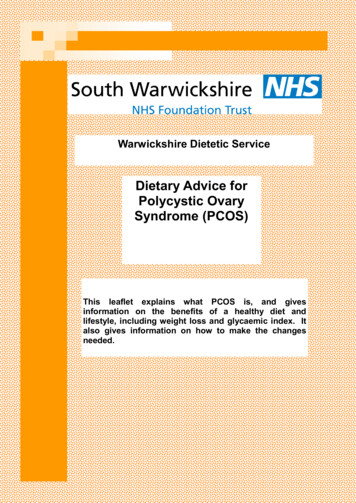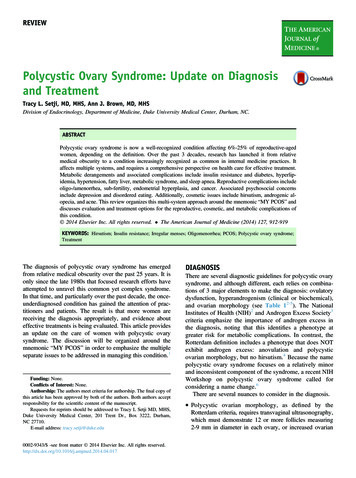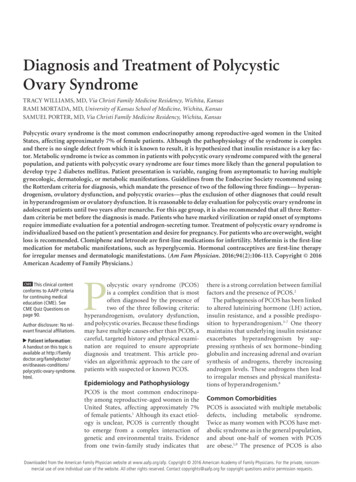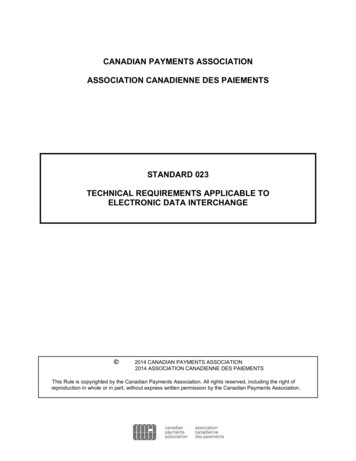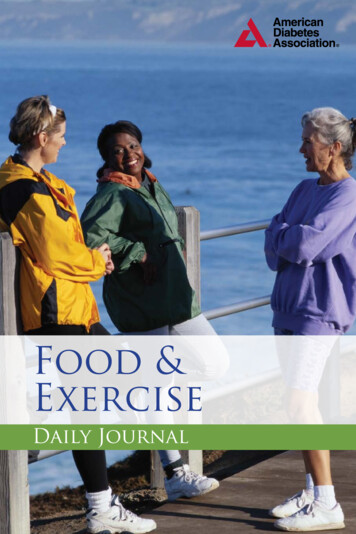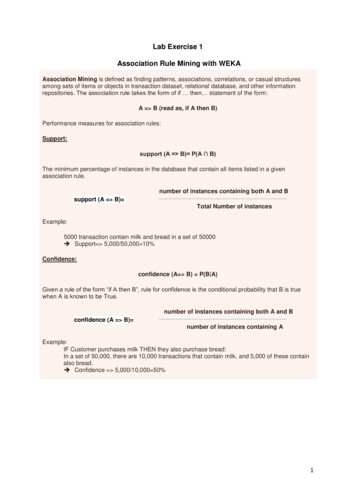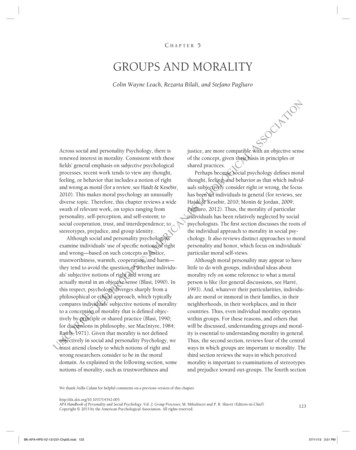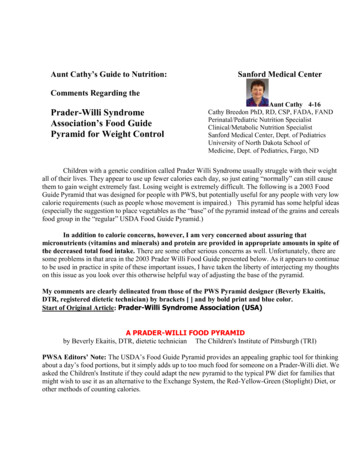
Transcription
Aunt Cathy’s Guide to Nutrition:Sanford Medical CenterComments Regarding thePrader-Willi SyndromeAssociation’s Food GuidePyramid for Weight ControlAunt Cathy 4-16Cathy Breedon PhD, RD, CSP, FADA, FANDPerinatal/Pediatric Nutrition SpecialistClinical/Metabolic Nutrition SpecialistSanford Medical Center, Dept. of PediatricsUniversity of North Dakota School ofMedicine, Dept. of Pediatrics, Fargo, NDChildren with a genetic condition called Prader Willi Syndrome usually struggle with their weightall of their lives. They appear to use up fewer calories each day, so just eating “normally” can still causethem to gain weight extremely fast. Losing weight is extremely difficult. The following is a 2003 FoodGuide Pyramid that was designed for people with PWS, but potentially useful for any people with very lowcalorie requirements (such as people whose movement is impaired.) This pyramid has some helpful ideas(especially the suggestion to place vegetables as the “base” of the pyramid instead of the grains and cerealsfood group in the “regular” USDA Food Guide Pyramid.)In addition to calorie concerns, however, I am very concerned about assuring thatmicronutrients (vitamins and minerals) and protein are provided in appropriate amounts in spite ofthe decreased total food intake. There are some other serious concerns as well. Unfortunately, there aresome problems in that area in the 2003 Prader Willi Food Guide presented below. As it appears to continueto be used in practice in spite of these important issues, I have taken the liberty of interjecting my thoughtson this issue as you look over this otherwise helpful way of adjusting the base of the pyramid.My comments are clearly delineated from those of the PWS Pyramid designer (Beverly Ekaitis,DTR, registered dietetic technician) by brackets [ ] and by bold print and blue color.Start of Original Article: Prader-Willi Syndrome Association (USA)A PRADER-WILLI FOOD PYRAMIDby Beverly Ekaitis, DTR, dietetic technician The Children's Institute of Pittsburgh (TRI)PWSA Editors’ Note: The USDA’s Food Guide Pyramid provides an appealing graphic tool for thinkingabout a day’s food portions, but it simply adds up to too much food for someone on a Prader-Willi diet. Weasked the Children's Institute if they could adapt the new pyramid to the typical PW diet for families thatmight wish to use it as an alternative to the Exchange System, the Red-Yellow-Green (Stoplight) Diet, orother methods of counting calories.
The Institute was glad to oblige but urges those who have been through the Institute’s program tocontinue using the Red-Yellow-Green Diet that they learned there. The Prader-Willi Food Pyramid thatfollows may not be appropriate for young children or for those on growth hormone therapy, and it shouldnot be considered substitute for individualized dietary guidance. Dietary guidance preferably should comefrom a nutritionist who is familiar with PWS.The Food Pyramid Guide to Daily Food Choices, designed by the U.S. Department of Agriculturefor adults who need 1,600 to 2,800 calories a day, represents the relative portions of foods to eat each day tomaintain a healthy weight and body. To make the Food Pyramid usable for people with Prader-WilliSyndrome, a few changes have to be made.The first change needed is to adjust the number of daily servings for each food group in order toreduce the total calorie level to 800 to 1,200 a day. These lower levels will provide for weight loss or ---------------------[CB note:It is potentially useful for others with very low caloric requirements as well, withthe same caveats described below. Actual calorie goals for PWS and non-PWSindividuals will vary considerably. Also, when establishing such a low calorie goal,consider that the daily values and other guidelines are usually based on a 2000 caloriediet. It is important to remember that such low calorie levels will invariably beinadequate in a number of nutrients unless careful supplementation is done. Failure toreplace these nutrients is not -------------------------
Second, although the five main food groups — bread, vegetable, fruit, meat, and milk —remain the same, the positions of two of the groups need to be changed on the pyramid toreflect a change in the recommended number of servings. Each group has a specific number ofservings that determines its position on the pyramid.The Food GroupsThe first USDA Food Pyramid (which had horizontal lines) has a base of the Breadgroup, which would provide the highest number of daily servings. The PW Pyramid, on theother hand, has as its base the Vegetable group, with 6-8 servings a day. For those familiarwith the Red-Yellow-Green Diet, these would be "GO" foods, i.e., foods low in calories andfat. Making the vegetable group the base of the pyramid and the bulk of the diet will allow alarge volume of food to be eaten without many additional calories.The Bread group, which includes cereal, pasta, and rice, moves up the pyramidwith a decrease in number of servings to three to five per day. We would also include starchyvegetables like corn, peas, and potatoes in this group because they have the same amount ofcalories per serving as breads.-----------------------------------[CB note: Try to use whole grains and foods that are naturally high infiber whenever able to improve the micronutrient content of the diet(especially magnesium, chromium and natural forms of vitamin E) and todecrease the potential for insulin resistance problems. (See my“Magnesium” and “Top Five Recommendations” papers for more on -----------------------The Fruit group includes fresh fruit, canned fruit, juice, and dried fruits. Many peoplethink of fruit as a "free" food. While it is a good snack and a good source of fiber and vitamins,it does have calories that should be counted if one is on a restricted diet. The daily servingsshould be four—one at each meal and one for snack.---------------------------------------[CB note:Choose whole fruit as much as possible instead of juices. If you usecanned fruit the juice-packed or water-packed are preferred oversyrup-packed products. Liquid carbohydrate calories consumed may be lesswell recognized as calories consumed by the body of some individuals, andso additional calories may be accidentally taken in. Excessive juice and“regular” pop consumption is suspected of being contributory to increasedweight gain in children in general.Interestingly, some people with carnitine inadequacy problems (asdiscussed later) will be particularly unable – and therefore unwilling -- to
limit carbohydrate of any kind (starch, fruit, sugar, etc.) because theycannot use fat for fuel well, and so carbohydrate foods are the only source ofenergy that they can reliably access. An example of this is a very heavyperson who simply cannot switch from “regular” soda to diet soda (or toother sugar-free beverages like water) no matter how many times we pointout those “150 empty calories per 12 oz can” labels and tell them they reallyneed to quit drinking all that pop.Unfortunately this is often interpreted as lack of will-power and acharacter flaw instead of recognizing that there is sometimes a uniquepattern of what kind of foods are especially sought out. In a number ofcases, I have found that correcting the fat metabolism problem withsupplemental carnitine can hugely facilitate the ability to make this changeto a lower intake of carbohydrates.I think this situation also has application in the model of some heavypeople being described as “addicted to sugar.” As some folks in the generalpopulation are now being identified as having compromised carnitineproduction (when we check) we may find that the same carnitinereplacement intervention takes the pressure off people with this problemwho are often actively seeking -----------------------------The Milk group includes yogurt, milk, and cheese. To fit the needs of the person withPWS, the servings per day should be two, and the products chosen should be nonfat or low infat. Fat-free, sugar-free frozen yogurt also can be used as a milk -------------------------[CB note: Be sure to provide additional calcium and vitamin D, asthe amount provided by the serving number shown here is clearlyinadequate for optimal health. MANY people (and over-weight individualsin particular) have been shown to require an intake of vitamin D well abovethe present RDA level.Now that blood levels are beginning to be checked more often, thevery large number of people with inadequate vitamin D levels in their bloodis being identified, and inadequacy is now recognized as being verydetrimental to heart health, muscle function, immune system function,prevention of cancer, autoimmune disorders, osteoporosis and bone pain.More on vitamin D will be discussed later.
Back to the specifics of the Pyramid:Note that the two cups of milk suggested will provide only 200 iu ofvitamin D, but PWS individuals should be provided with at least 2000-5000iu daily simply to maintain levels associated with optimal health. Evenmore may be shown to be needed for some individuals. Also, in this context,the 2000-5000 iu is a maintenance level, not a level to treat deficiency, whichcould be much more than that.Most cheese, yogurt and other dairy products do not provide anyvitamin D at all and if some has been added in certain brands, it is still atthe same too-low amount as is added to milk (i.e. 100 iu/cup.)Vitamin D deficiency is extremely common, generally unrecognized,and contributory to increased risk of cancer, muscle weakness, muscle pain,heart disease, MS, arthritis, diabetes, compromised immune function andmore. It is now being described as an “unrecognized epidemic” in thegeneral public, and the World Health Organization (WHO) estimates thatabout half of the world’s population is vitamin D deficient.People who are overweight have an additional risk of vitamin Ddeficiency. A good plan would be to check the vitamin D level in the winterand if deficiency is found, the physician would then order a specialhigh-dose catch-up amount (a “therapeutic dose”), which would be followedby an intake equivalent to at least a 2000 iu/daily maintenance level. Somepeople require 5,000 iu for maintenance it is quite variable amongindividuals. One example of a therapeutic dose is 50,000 iu/week for 8weeks, followed by a re-check and sometimes another round of that level ofsupplementation.The serum (blood) level that is associated with optimal health is aminimum of 40 iu; the older lab sheets say that 25 is the lower end ofnormal, but that level has been shown to be insufficient for many of theknown functions of vitamin D, such as cancer prevention and musclestrength. The current lower end of the normal range is 30 but it looks likethere are many health benefits associated with levels in the range of 40-60.People with PWS have several additional risk factors for deficiencythat lead me to recommend that it would be wise to get a vitamin D levelmeasured annually in the winter (the lab to order is the “25-hydroxyvitamin D” measurement) unless the individually reliably takes a 5,000 iu
vitamin D as a gel cap or tablet daily. (See my “Top FiveRecommendations” handout or my more detailed paper just on vitamin Dfor more ------------------------------The Meat group includes meat, fish, poultry, eggs, peanut butter, and cooked driedbeans. The USDA also includes nuts in this group, but due to their high fat content theyshould be eliminated from the PW -------------------------[CB note: Although nuts and peanut butter are higher in caloriesthan some foods, they are also quite nutrient-dense and they are among therichest source of dietary magnesium, a mineral that is often low inAmerican diets, and which is extremely metabolically important.In children and adults who are significantly overweight, magnesiummay make a difference between whether or not one goes on to developinsulin resistant (type 2) diabetes. Additionally, magnesium inadequacy cancontribute to obesity itself by making it hard to convert fuel from food intousable energy. (See “Magnesium” handout and “Top FiveRecommendations” handout.)The fat in nuts and legumes is of the more “heart friendly” type – richin the type of fat called “monounsaturated” fat. Also, although fat hasmore calories per ounce than carbohydrate or protein, it is useful to notethat in non-PWS individuals a more generous fat content per se does notseem to be associated with increased fatness or decreased weight loss as longas one stays within the target caloric level.However, people with PWS appear to have difficulty doing anythingwith the fat they eat except store it. Restricting the proportion of caloriesfrom fat is reasonable, but as is discussed later, there are ways to help themuse the fat more normally. In that situation, restricting fat specificallywould become a much less important goal. Similarly, limiting consumptionof fat does not prevent the production of fat from extra calories taken infrom protein and carbohydrate.Nuts and peanuts also provide protein and the protein and fat contentboth contribute to a sense of satiety for most people. It helps them not gethungry again so soon, and it has been shown to be true for many other
groups of people who are trying to “watch calories.” Whether this is true forpeople with PWS is not known it appears that the drive to eat iscontrolled by a different mechanism than the sense of satiety associated withstomach fullness, as described further -----------------------And the USDA suggests two to three meat servings per day of 2½-to-3-oz. portions. Todecrease the calories for the PW meal plan, we changed the portion size to 2 oz. and suggestone to two servings a day. This means that a person on 800 calories could divide the 2 oz.serving to provide 1 oz. at lunch and 1 oz. at dinner, and a person on 1,200 calories could have2 oz. at lunch and 2 oz. at ------------------------[CB note :Dried beans and peas – kidney beans, navy beans, lentils, split peas,etc. – are terrific foods for people with weight problems. They aregenerous in magnesium, chromium and many other nutrients that help ususe our calories appropriately, and they are also low in fat and high in fiber.They are a good source of protein, they are ‘filling,’ and their carbohydrateis in a form that has a low ‘glycemic index.’The amount of total protein needs to be at least adequate to maintainmuscle mass and many protein-dependent functions. That mean that afterremoving servings of meat, etc., it is important for people designing the dietto check that the total protein is not inadequate. It easily could be if thecalorie allowance is quite restrictive.The World Health Organization suggests that a minimum of about 1gram protein per kg body weight is needed by everyone. In comparison,most Americans eat two to three times this amount.Some people calculate this protein requirement in PWS using theindividual’s actual weight, some use the average weight for people of theperson’s height, and some folks split the difference and find the mid-rangebetween those two numbers. If the lowest protein-allowance versionabove is chosen (i.e. 1 g/kg using average weight for height,) follow-upevaluation of protein status is essential. Nobody benefits from proteindeficiency.
Diets based on ‘low glycemic index’ foods appear to result in moreweight loss than a “low fat” diet even when both diets provided the samenumber of calories. However as before these observations may not bethat useful in coping with the metabolic problems of people with PWS.However, it may be helpful to people with PWS as well if it results in fewerepisodes of elevated blood sugar after eating, perhaps by avoiding excessivestimulation of insulin. Hyperinsulinemia itself can be contributory toexcessive weight gain.It is also reasonable to provide at least 1000 mg fish oil daily or to eat“fatty fish” twice weekly (as is recommended for everyone by the AmericanHeart Association.) There are many reasons for this please see my “TopFive Recommendations” paper for more general explanation. The reason itwould be particularly reasonable in PWS is because missing part of achromosome (or other metabolic conditions like diabetes) can affectproduction of many things we usually make for ourselves, such as thelong-chain omega-3 fats EPA and DHA. That is, they become “essential.”These fats have many special roles in health, including eye health,brain development and decreasing inflammatory conditions. The“ready-to-go” form of EPA and DHA needed for many of these activities isin fish oil. Vegetable oils have none. Meat, eggs, and dairy fats generallyhave little or none. (Some specially produced products are becomingavailable by feeding animals differently, but the amount is not enough torely on in this situation, and they are pricey.) The caloric contribution isvery small compared to the potential health benefit of providing some.This small amount is designed to assure adequacy of key substances toperform important metabolic roles; it is not primarily being provided as acalorie source nor should it be counted as one. I standardly recommendedit for all the children I work with who have metabolic problems and alsofor all those who do not have any particular health problem. I take itmyself and make my husband take it too.One additional caveat is that some people with PWS develop Type IIdiabetes and may be put on the medication Metformin/Glucophage. Thismedication has been shown to cause significant impairment of vitamin B12status, which can cause neurologic injury. I recommend that anyone on thismedication at least be monitored with an annual vitamin B12 level.
Note that if the level is dropping even though still in the normal range,it suggests that they are using up stored vitamin B12 and are likely todevelop deficiency even if it is not seen now. A blood test showing highMCV (Mean Cell Volume) is a very late-appearing symptom of vitamin B12deficiency. The changes in cell size occur when the person is no longer ablemake adequate DNA this should not be used as a screening test.)If generous oral vitamin B12 does not correct the problem (which itdefinitely may not do with this medication in the picture,) consider avitamin B12 shot to bypass the intestinal impairment of vitamin B12absorption that is associated with use of this medication. Vitamin B12deficiency is very dangerous. It causes neurologic damage and impairsproduction of DNA. The latter problem can’t be good since DNA is neededto make nearly all one’s cells.I have found overt vitamin B12 deficiency in several adolescents withPWS who were new to our clinic and who had never had it evaluated.Neurologic symptoms are often not recognized in people who have manyother health issues. It is assumed to be just a symptom of the syndrome.As noted earlier, another potential diabetes-related factor is thatinadequacy of the minerals magnesium and chromium will make insulinreceptors on the cells be less able to work. In other words, micronutrientinadequacy can be an additional contributor to the increased risk of peoplewith PWS developing and having trouble controlling type 2 diabetes.Assuring adequacy instead of assuming it is always the way to go.Please see my “Vitamin B12” paper or my “Other Nutrition Issues inDiabetes” paper for more detail on this phenomenon, and some othermonitoring ---Serving Sizes:Except for the meat group, the serving sizes on our PW Pyramid are unchanged fromthe USDA Food Pyramid. They are as follows:Vegetable: ½ cup cooked or 1 cup rawBread: 1 slice bread; ½ C. rice, pasta, or starchy vegetable; 1 oz. Cereal
Fruit: ½ C. canned, ½ C. or 1 piece fresh, 1/4 C. dried; ½ C. juiceMilk: 1 C. skim milk or lite yogurt, 1 oz. cheese, ½ C. frozen fat-free sugar-free yogurtMeat: 2 oz. cooked lean meat, fish, poultry; 1 egg; ½ C. cooked dried beans; 2 T peanut butterFats, Oils, and SweetsThe top of the USDA Pyramid shows fats, oils, and sweets. These are denoted bysymbols that are concentrated in this area and dispersed throughout the other groups. TheUSDA suggests that these foods be used sparingly to add extra calories. These foods includebutter, margarine, regular dressings, candy, sugars, sweets, fatty desserts, gravy, and friedfoods, to name a few. The foods from this group add unwanted calories and few nutrients to thePrader-Willi diet. They should be limited to once a month for an 800-calorie plan and once aweek for a 1,200-calorie plan. We have deleted the fat symbols throughout the PW Pyramid,because all foods chosen should be low in fat and sugar.Using this modified pyramid as a guide to weight loss and maintenance, in conjunctionwith a favorite exercise program, can be an easy way to ensure a healthy, nutritious diet for theperson with Prader-Willi --------------------------[CB note: Following this plan will result in very poor micronutrientbalance unless a number of vitamins and minerals are supplemented. Thisincludes inadequacies of many nutrients that are not included in a standardmultivitamin with minerals.Other nutrition-related substances are also looking to be important inPWS, including certain special forms of fat and some “conditionallyessential” substances that we normally make in adequate amountsourselves. Conditionally essential simply means that in certain conditions like having PWS, for example, ready-made versions of the substancesare actually essential.An extremely important consideration is that is that there is clearly ametabolic component to weight issues in Prader Willi Syndrome. They arenot being “piggy” or “lazy.” Something in their bodies is not working rightand they are trying desperately to compensate for it with predictableresults:The well-recognized features of PWS include an intense drive to eateven when allowed to consume a very generous amount of food.
Additionally, they often accumulate very generous body fat, and they tendto have hypotonia (low muscle tone) and very poor exercise endurance.These features of the syndrome make it necessary to look at more thanseverely cutting their calories and pushing for increase physical activity inan effort to avoid fatness.Restricting calories does not help the drive to eat at all, nor does ittruly solve the excess fat accretion or muscle issues. This collection ofsymptoms can often reflect a metabolic problem that requires the person tobe provided with a substance called carnitine, and our experience withchildren who have received carnitine supplementation has borne this out.Carnitine is normally made in ample amounts in one’s body, but thereare a number of situations in which it is not made in normal amounts, or inwhich a person has much higher than usual needs. In a nutshell, carnitinehas an important role in everyone’s ability to burn fat for fuel.Failure to efficiently burn fat for fuel means that fat will be stored butthen it is unable to be made available for use as fuel. That means that forpractical purposes, the fat consumed with a meal and the fat already storedin the body do not contribute to the job of running a person’s body.One’s brain then makes “getting some fuel” an extremely highpriority hence the intense food-seeking behavior even in the presence ofclearly generous energy stores and a generous amount of food eaten.Maintaining normal muscle tone also requires carnitine becausemuscles preferentially burn fat for fuel, especially in endurance activities.Muscle weakness and poor exercise tolerance result from inability to burnfat fuel normally, which then impairs the pursuit of the physical activityencouraged as part of a weight management program. Further, the heartis a muscle cardiomyopathy and hypotonia (low muscle tone) is oftenassociated with carnitine insufficiency.When health care professionals only focus on the caloric restrictionissue, they can contribute to big problems for families. They often put theresponsibility for preventing obesity on the shoulders of the caretakers withmessages like “It’s your job to just tell her ‘no’ when she wants more food.”Consider that when health professionals say this kind of thing, they areasking a parent to consistently refuse food to a child who is begging andpleading for it.
Imagine the hungriest you have ever felt, and then imagine thatpeople with PWS feel that way all the time. They experience intensediscomfort from hunger cutting food intake down to half the amountother people get to eat does not solve this problem. It may prevent obesityto some degree, but it makes their discomfort worse and it can have a verynegative on behavior and relationships.One promising non-nutritional intervention is the use of growthhormone. There are nutrition-related substances under investigation aspotentially helpful in muscle operation in PWS as well, such as CoQ-10. Inour clinic, we have seen tremendous benefit to individual babies andchildren from the combination of growth hormone, carnitine and CoQ-10.It has worked better in combination than with the (already standardly used)growth hormone therapy alone. The metabolic adjustment seems to makethat expensive growth hormone more effective.(Whether or not growth hormone therapy would be useful for a childwith PWS is something his/her physician would need to determine. Myonly point here is that IF hormone therapy is tried, it might work better ifsome of these identified metabolic nutrition issues are addressed before thetrial period.)The benefits include better lean body mass, BMI or weight-for-length,and muscle tone. It has significantly improved the classic intensefood-seeking behavior. Severely hypotonic babies who started the carnitineand CoQ-10 upon diagnosis in the nursery have been able to suck wellenough to go home without the gastrostomy tube placement often needed inearly life. They move more vigorously.There is a lot more to learn, but the carnitine and CoQ-10 are verysafe and very promising in some reports and small studies for children withPWS and other serious medical conditions with metabolic derangements.But large-scale long-term randomly-assigned prospective studies will take along time to get. For that reason the use of carnitine and CoQ-10 in thisapplication is not the official recommendation of large medical groups yet.Please note that I do not sell anything nor do I have any relationshipwith manufacturers of these substances. Additionally, I never goANYWHERE near “scary” in my recommendations. But if it were MYchild who had PWS, I would surely do a trial on these substances while weawait the long-term large research studies that are always needed. There
are supportive preliminary reports in the scientific literature, and alsoanecdotal information from parents and from people like me who followpatients with PWS. For any particular child it will either help or it won’t,and I think it is certainly worth a trial. Stay tuned!One other very new addition to the collection of possibly conditionallyessential substances of interest in PWS is “NAC” -- N-acetylcysteine (calledPharma-NAC ) It is showing some promise in addressing the problem ofskin-picking that is common in PWS. No recommendation is being madehere this is not my territory but because this is so new, here is theabstract of a study investigating its use so that interested pharmacy andphysician folks can look into it further.---An open-label pilot study ofN-acetylcysteine for skin-picking in Prader-Willi syndrome.Am J Med Genet A. 2014 Feb;164A(2):421-4.Miller JL, Angulo M. Dept of Pediatrics-Endocrinology, University of Florida, Gainsville, Florida.Prader-Willi syndrome (PWS) is a complex neurodevelopmental disorder caused by anabnormality on the long arm of chromosome 15 (q11-q13) that results in a host of behavioralcharacteristics including excessive interest in food, skin picking, difficulty with a change inroutine, and obsessive and compulsive behaviors. Skin-picking can result in serious andpotentially life-threatening infections. Recent evidence suggests that the excitatoryneurotransmitter glutamate is dysregulated in obsessive-compulsive behaviors, andmodulation of the glutaminergic pathway may decrease compulsive behaviors, such asrecurrent hair pulling or skin-picking behaviors. N-acetylcysteine (NAC), a derivative of theamino acid cysteine, is thought to act either via modulation of NMDA glutamate receptors or byincreasing glutathione in pilot studies. Thirty-five individuals with confirmed PWS (ages 5-39years, 23 females/12 males) and skin-picking behavior for more than 1 year were treated withN-acetylcysteine (Pharma-NAC ) at a dose of 450-1,200 mg/day. Skin-picking symptoms andopen lesions were assessed after 12 weeks of treatment by counting and measuring lesionsbefore and after the medication. All 35 individuals had improvement in skin-pickingbehaviors.Ten (29%) individuals (six males and four females) did not have complete resolutionof skin-picking behavior, but had significant reduction in the number of active lesions.Longer-term, placebo-controlled trials are needed to further assess the potential benefit of thistreatment.
Summary about the Use of the PWS Pyramid:The PWS pyramid above is a reasonable starting place for approaching aweight problem in general it illustrates a simple way to identify the food groupswith various calorie levels.However, the individual who designed it was essentially only address
reduce the total calorie level to 800 to 1,200 a day. These lower levels will provide for weight loss or PWS. ----- [CB note: It is potentially useful for others with very low caloric requirements as well, with the same caveats described below. Actual calorie goal
